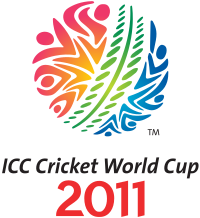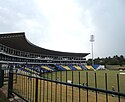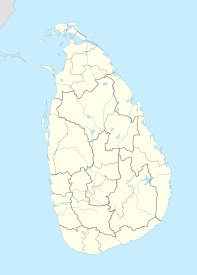
A | B | C | D | E | F | G | H | CH | I | J | K | L | M | N | O | P | Q | R | S | T | U | V | W | X | Y | Z | 0 | 1 | 2 | 3 | 4 | 5 | 6 | 7 | 8 | 9
 Official logo | |
| Dates | 19 February – 2 April 2011 |
|---|---|
| Administrator(s) | International Cricket Council |
| Cricket format | One Day International |
| Tournament format(s) | Round-robin and Knockout |
| Host(s) | |
| Champions | |
| Runners-up | |
| Participants | 14 (from 104 entrants) |
| Matches | 49 |
| Attendance | 1,229,826 (25,098 per match) |
| Player of the series | |
| Most runs | |
| Most wickets |
|
The 2011 ICC Cricket World Cup was the tenth Cricket World Cup. It was played in India, Sri Lanka, and for the first time in Bangladesh. India won the tournament, defeating Sri Lanka by 6 wickets in the final at Wankhede Stadium in Mumbai, thus becoming the first country to win the Cricket World Cup final on home soil.[1][2] India's Yuvraj Singh was declared as the player of the tournament.[3] This was the first time in World Cup history that two Asian teams had appeared in the final. It was also the first time since the 1992 World Cup that the final did not feature Australia.
Fourteen national cricket teams took part in this tournament, including 10 full members and four associate members of the International Cricket Council (ICC).[4] The opening ceremony was held on 17 February 2011 at Bangabandhu National Stadium, Dhaka,[5] and the tournament was played between 19 February and 2 April. The first match was played between India and Bangladesh at the Sher-e-Bangla National Stadium in Mirpur, Dhaka.[6]
Pakistan was also scheduled to be a co-host, but after the 2009's terrorist attack on the Sri Lanka national cricket team in Lahore, the ICC cancelled that,[7] and the headquarters of the organising committee, originally in Lahore, was transferred to Mumbai.[8] Pakistan was to have held 14 matches, including one semi-final.[9] Eight of the games (including the semi-final) were awarded to India, four to Sri Lanka, and two to Bangladesh.[10]
Host selection
The International Cricket Council (ICC) announced on 30 April 2006 which countries would host the 2011 World Cup. Australia and New Zealand had also bid for the tournament; if successful, they would have shared the hosting equally, leaving the location of the final still to be decided. The Trans–Tasman bid, Beyond Boundaries, was the only one delivered to the ICC headquarters in Dubai before the 1 March deadline, but the Asian bidders were granted an extension by the ICC.[11] The New Zealand government had given assurance that Zimbabwe would be allowed to compete in the tournament, following political discussions in the country over whether their cricket team should be allowed to tour Zimbabwe in 2005.[citation needed]
The extra time needed for the Asian bid had weakened its prospects, but when the time came to vote, Asia won the hosting rights by ten votes to three.[11] The Pakistan Cricket Board (PCB) has revealed that the vote of the West Indies Cricket Board was decisive, as the Asian bid had the support of South Africa and Zimbabwe as well as the four bidding countries.[12] The Pakistani newspaper Dawn reported that the Asian countries had promised to hold fund-raising events for West Indian cricket during the 2007 World Cup, which may have influenced the vote.[13] However, I. S. Bindra, chairman of the Monitoring Committee of the Asian bid, said that their promise of extra profits of around US$400 million had been decisive,[14] that there "was no quid pro quo for their support",[15] and that playing the West Indies had "nothing to do with the World Cup bid".[15]
Format
Late in 2007, the four host nations agreed on a revised format for the 2011 World Cup, identical to that of the 1996 World Cup, except that there would be 14 teams instead of 12. The first round of the tournament would consist of two groups of seven teams. Each team in a group would play all the others once, and the top four from each group would qualify for the quarter-finals.[16] This ensured that every team would play at least six matches.
Qualification
As per ICC regulations, all 10 full members automatically qualify for the World Cup, including Zimbabwe who have given up their Test playing status until the standard of their team improves.[17]
The ICC also organised a qualifying tournament in South Africa to determine the four associate teams who would participate in the 2011 event. Ireland, who had been the best performing associate nation since the last World Cup, won the tournament, beating Canada in the final. The Netherlands and Kenya also qualified by virtue of finishing third and fourth respectively.[18] All 4 associates kept their ODI status as well as Scotland who this time failed to qualify for the World Cup.
List of qualified teams
The following 14 teams qualified for the final tournament.
| Group A | Group B | ||
|---|---|---|---|
| Rank | Team | Rank | Team |
| Full Members | |||
| 1 | 2 | ||
| 3 | 4 | ||
| 5 | 6 | ||
| 7 | 8 | ||
| 9 | 10 | ||
| Associate Members | |||
| 11 | 12 | ||
| 13 | 14 | ||
Preparations

Pakistan loses co-host status
In April 2009, the ICC announced that Pakistan had lost its right to co-host the 2011 World Cup because of concerns about the "uncertain security situation" in the country, especially in the aftermath of the 2009 attack on the Sri Lanka national cricket team in Lahore.[19][20] The PCB estimated that this would lose them $10.5 million.[21] This figure took account only of the fees of $750,000 per match guaranteed by the ICC. The overall loss to the PCB and the Pakistani economy were expected to be much greater.
On 9 April 2009, PCB chairman Ijaz Butt revealed that they had issued a legal notice to oppose ICC's decision.[22] The ICC, however, claimed that the PCB was still a co-host, and that they had only relocated the matches out of Pakistan.[23] Pakistan proposed that South Asia host the 2015 World Cup and that Australia and New Zealand host the 2011 event, but this option did not find favour with their co-hosts and was not implemented.[24]
Allocation of matches
On 11 April 2005, PCB chairman Shahryar Khan announced an agreement on the allocation of games,[25] under which India would host the final, Pakistan and Sri Lanka the semi-finals,[26] and Bangladesh the opening ceremony.[27] After being stripped of its status as a co-host, Pakistan proposed to host its allocated games in the United Arab Emirates as a neutral venue. They had played matches in Abu Dhabi, Dubai, and Sharjah in the preceding months.[citation needed] On 28 April 2009, however, the ICC announced that matches originally intended to be played in Pakistan would be reallocated. As a result, India hosted 29 matches across eight venues, including the final and one semi-final; Sri Lanka hosted 12 matches at three venues, including one semi-final; and Bangladesh hosted 8 matches at two grounds, as well as the opening ceremony on 17 February 2011.[28]
On 1 June 2010, the first tranche of tickets were put on sale after a meeting of the tournament's Central Organising Committee in Mumbai. The cheapest tickets cost 20 US cents in Sri Lanka.[29] In January 2011, the ICC declared the Eden Gardens ground in Kolkata, India, to be unfit and unlikely to be complete by 27 February, when it was scheduled to host a match between India and England. The match was moved to Bangalore.[30]
Media and promotion
The World Cup has grown as a media event with each tournament.[citation needed] The ICC sold the broadcasting rights for the 2011 event to ESPN Star Sports and Star Cricket for around US$2 billion.[citation needed] For the first time, the tournament was broadcast in high-definition format, and it was to be covered by at least 27 cameras using recent technology. It was also planned to be shown across platforms such as online and mobile 3G. It was the first time that an ICC event had the Umpire Decision Review System (UDRS).[31]
The final was watched live by 135 million people in India,[32][33] as recorded by the ratings agencies TAM and aMap, including 67.6 million Indian cable and satellite viewers.[34] The final was watched by 13.6% of Indian TV-equipped households on average, with a peak of 21.44% at the end of the game,[35] thus beating the semi-final between India and Pakistan, which had an estimated 11.74% TV rating in India for the whole match.[33]
The official event ambassador was Sachin Tendulkar.[36]
Song
The official song of the 2011 Cricket World Cup has three versions, in Bengali, Hindi and Sinhala, corresponding to the three host countries.[37] "De Ghuma Ke" (Swing It Hard) is the Hindi version, composed by the trio of Shankar–Ehsaan–Loy.[38] It employs an array of Indian rhythms combined with elements of rock and hip hop. The Sinhala version, "Sinha Udaane", was adapted by Sri Lankan R&B and hip hop artist Ranidu Lankage and composed by lyricist Shehan Galahitiyawa.[37] Both songs were performed at the opening ceremony. "Sinha Udaane" was performed by Lankage.[39]
Mascot
Stumpy, a young elephant, was the official mascot for the 2011 Cricket World Cup.[40] He was unveiled at a function in Colombo, Sri Lanka, on 2 April 2010,[41] and his name was revealed on 2 August 2010 after an online competition conducted by the ICC in the last week of July.[42]
Opening ceremony
The opening ceremony was held in the Bangabandhu National Stadium in Dhaka, Bangladesh, on 17 February 2011, two days before the first match.
Prize money
The 2011 Cricket World Cup winning team would be taking home a prize money of US$3 million and US$1.5 million for runner-up, with the ICC deciding to double the total allocation for the tournament to US$8.01 million. The winning team was also awarded a replica of the Cricket World Cup Trophy, a practice that originated in 1999. The decision was taken at the ICC Board meeting which was held in Dubai on 20 April 2010.[43]
- US$250,000 – Losing quarter-finalists (4 teams)
- US$500,000 – Losing semi-finalists
- US$1,500,000 – Runners-up
- US$3,250,000 – Winners
Venues
All the Indian stadiums for the tournament had been finalised by mid-October 2009,[44] and those of Bangladesh and Sri Lanka in late October 2009. The ICC announced all the venues in Mumbai on 2 November 2009. Two new stadiums were constructed in Kandy and Sooriyawewa, Sri Lanka, for the event.[45]
| India | ||||
|---|---|---|---|---|
| Kolkata | Chennai | Delhi | Nagpur | Ahmedabad |
| Eden Gardens | M. A. Chidambaram Stadium | Feroz Shah Kotla Stadium | Vidarbha Cricket Association Stadium |
Sardar Patel Stadium |
| Capacity: 66,349 | Capacity: 50,000 | Capacity: 41,820 | Capacity: 45,000 | Capacity: 54,000 |

|

|

|

|

|
| Mumbai | Mohali | Bangalore | ||
| Wankhede Stadium | Punjab Cricket Association Stadium |
M. Chinnaswamy Stadium | ||
| Capacity: 33,108 | Capacity: 26,950 | Capacity: 40,000 | ||

|

|

|
||
| Sri Lanka | Bangladesh | |||
| Colombo | Kandy | Sooriyawewa | Chittagong | Dhaka |
| R. Premadasa Stadium | Pallekele International Cricket Stadium |
Mahinda Rajapaksa International Cricket Stadium |
Zohur Ahmed Chowdhury Stadium |
Sher-e-Bangla National Cricket Stadium |
| Capacity: 35,000 | Capacity: 35,000 | Capacity: 35,000 | Capacity: 20,000 | Capacity: 26,000 |

|

|

|

|

|
|
Venues in Sri Lanka |
Venues in Bangladesh |
Umpires
The umpire selection panel selected 18 umpires excluding a reserve umpire, Enamul Haque (Bangladesh) to officiate at the World Cup: five from Australia, three from England, two each from India, New Zealand, Pakistan and Sri Lanka, and one each from South Africa and the West Indies.
|
Australia New Zealand
|
South Africa Pakistan India
|
England Sri Lanka West Indies
|
Squads
Each country chose a 30-member preliminary squad, which would then be reduced to 15. All the 14 teams announced their final squads before 19 January 2011. Sachin Tendulkar of India played in his sixth consecutive world cup, equalling the record of Javed Miandad (PAK).
Warm-up matches
The following 14 warm-up matches were played before the World Cup started, between 12 February and 18 February 2011.[46][47] All 14 nations that were qualified to take part in the World Cup participated in a series of matches to prepare, experiment with different tactics and to help them acclimatise to conditions in the Indian Subcontinent. The warm-up matches were not classified as One Day Internationals by the ICC, despite sharing some of main features of this form of cricket, but some of the playing regulations were different from standard internationals in order to allow teams to experiment. For example, the main change allowed for thirteen different players to play in a match – nine players being allowed to both bat and bowl, with two only being able to bowl and two only being able to bat – instead of the eleven players normally allowed.
England, India, Sri Lanka and South Africa were the only teams to win both of their warm-up games, while Australia, Canada, Kenya and Zimbabwe did not win either of their fixtures.
Match status
As of 2007, none of the warm-up games were officially recognised as ODIs or List A matches by the ICC due to various changes in the rules of the game, and this continued into the 2011 World Cup.[48] While normally only 11 players are allowed to bat and field (excluding situations involving a substitute fielder),[49] 13 players were used in each team's squad for the matches – 11 of whom were allowed to field at one time and 11 of whom were allowed to bat (meaning players could be swapped in and out when fielding or bowling, but two players did not bat in a match).[50] In official ICC matches match referees are required to help officiate a game, but due to the changes in the rules none were appointed for any of the warm-up games.[48][51]
Schedule and results
Warm-up matches
v
|
Text je dostupný za podmienok Creative Commons Attribution/Share-Alike License 3.0 Unported; prípadne za ďalších podmienok. Podrobnejšie informácie nájdete na stránke Podmienky použitia.
Antropológia
Aplikované vedy
Bibliometria
Dejiny vedy
Encyklopédie
Filozofia vedy
Forenzné vedy
Humanitné vedy
Knižničná veda
Kryogenika
Kryptológia
Kulturológia
Literárna veda
Medzidisciplinárne oblasti
Metódy kvantitatívnej analýzy
Metavedy
Metodika
Text je dostupný za podmienok Creative
Commons Attribution/Share-Alike License 3.0 Unported; prípadne za ďalších
podmienok.
Podrobnejšie informácie nájdete na stránke Podmienky
použitia.
www.astronomia.sk | www.biologia.sk | www.botanika.sk | www.dejiny.sk | www.economy.sk | www.elektrotechnika.sk | www.estetika.sk | www.farmakologia.sk | www.filozofia.sk | Fyzika | www.futurologia.sk | www.genetika.sk | www.chemia.sk | www.lingvistika.sk | www.politologia.sk | www.psychologia.sk | www.sexuologia.sk | www.sociologia.sk | www.veda.sk I www.zoologia.sk




